Mikko Valkama
Sensing with Mobile Devices through Radio SLAM: Models, Methods, Opportunities, and Challenges
Sep 09, 2025Abstract:The integration of sensing and communication (ISAC) is a cornerstone of 6G, enabling simultaneous environmental awareness and communication. This paper explores radio SLAM (simultaneous localization and mapping) as a key ISAC approach, using radio signals for mapping and localization. We analyze radio SLAM across different frequency bands, discussing trade-offs in coverage, resolution, and hardware requirements. We also highlight opportunities for integration with sensing, positioning, and cooperative networks. The findings pave the way for standardized solutions in 6G applications such as autonomous systems and industrial robotics.
Failure Tolerant Phase-Only Indoor Positioning via Deep Learning
Aug 20, 2025Abstract:High-precision localization turns into a crucial added value and asset for next-generation wireless systems. Carrier phase positioning (CPP) enables sub-meter to centimeter-level accuracy and is gaining interest in 5G-Advanced standardization. While CPP typically complements time-of-arrival (ToA) measurements, recent literature has introduced a phase-only positioning approach in a distributed antenna/MIMO system context with minimal bandwidth requirements, using deep learning (DL) when operating under ideal hardware assumptions. In more practical scenarios, however, antenna failures can largely degrade the performance. In this paper, we address the challenging phase-only positioning task, and propose a new DL-based localization approach harnessing the so-called hyperbola intersection principle, clearly outperforming the previous methods. Additionally, we consider and propose a processing and learning mechanism that is robust to antenna element failures. Our results show that the proposed DL model achieves robust and accurate positioning despite antenna impairments, demonstrating the viability of data-driven, impairment-tolerant phase-only positioning mechanisms. Comprehensive set of numerical results demonstrates large improvements in localization accuracy against the prior art methods.
Phase-Only Positioning: Overcoming Integer Ambiguity Challenge through Deep Learning
Jun 09, 2025Abstract:This paper investigates uplink carrier phase positioning (CPP) in cell-free (CF) or distributed antenna system context, assuming a challenging case where only phase measurements are utilized as observations. In general, CPP can achieve sub-meter to centimeter-level accuracy but is challenged by the integer ambiguity problem. In this work, we propose two deep learning approaches for phase-only positioning, overcoming the integer ambiguity challenge. The first one directly uses phase measurements, while the second one first estimates integer ambiguities and then integrates them with phase measurements for improved accuracy. Our numerical results demonstrate that an inference complexity reduction of two to three orders of magnitude is achieved, compared to maximum likelihood baseline solution, depending on the approach and parameter configuration. This emphasizes the potential of the developed deep learning solutions for efficient and precise positioning in future CF 6G systems.
Pilot-Based End-to-End Radio Positioning and Mapping for ISAC: Beyond Point-Based Landmarks
May 12, 2025Abstract:Integrated sensing and communication enables simultaneous communication and sensing tasks, including precise radio positioning and mapping, essential for future 6G networks. Current methods typically model environmental landmarks as isolated incidence points or small reflection areas, lacking detailed attributes essential for advanced environmental interpretation. This paper addresses these limitations by developing an end-to-end cooperative uplink framework involving multiple base stations and users. Our method uniquely estimates extended landmark objects and incorporates obstruction-based outlier removal to mitigate multi-bounce signal effects. Validation using realistic ray-tracing data demonstrates substantial improvements in the richness of the estimated environmental map.
UNILoc: Unified Localization Combining Model-Based Geometry and Unsupervised Learning
Apr 24, 2025Abstract:Accurate mobile device localization is critical for emerging 5G/6G applications such as autonomous vehicles and augmented reality. In this paper, we propose a unified localization method that integrates model-based and machine learning (ML)-based methods to reap their respective advantages by exploiting available map information. In order to avoid supervised learning, we generate training labels automatically via optimal transport (OT) by fusing geometric estimates with building layouts. Ray-tracing based simulations are carried out to demonstrate that the proposed method significantly improves positioning accuracy for both line-of-sight (LoS) users (compared to ML-based methods) and non-line-of-sight (NLoS) users (compared to model-based methods). Remarkably, the unified method is able to achieve competitive overall performance with the fully-supervised fingerprinting, while eliminating the need for cumbersome labeled data measurement and collection.
Detection with Uncertainty in Target Direction for Dual Functional Radar and Communication Systems
Dec 10, 2024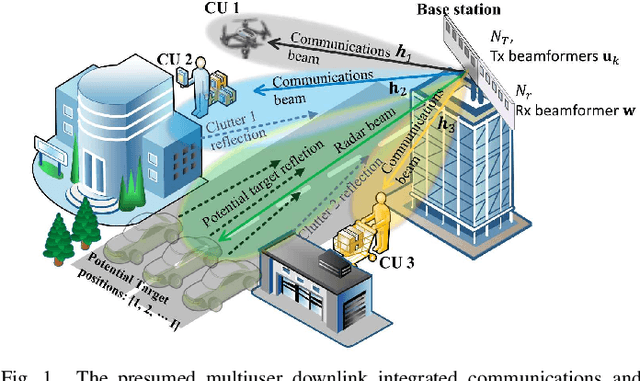
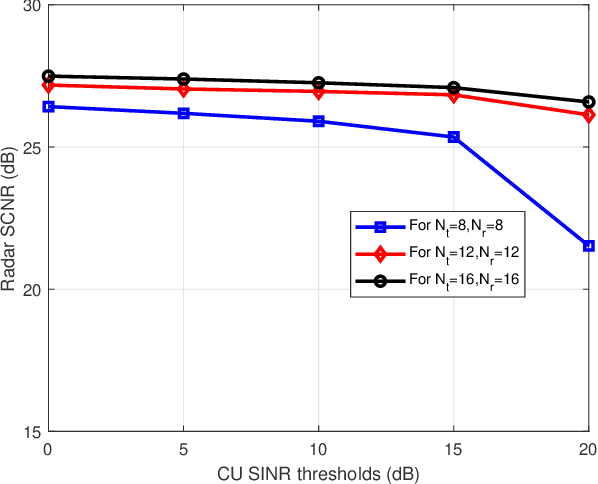
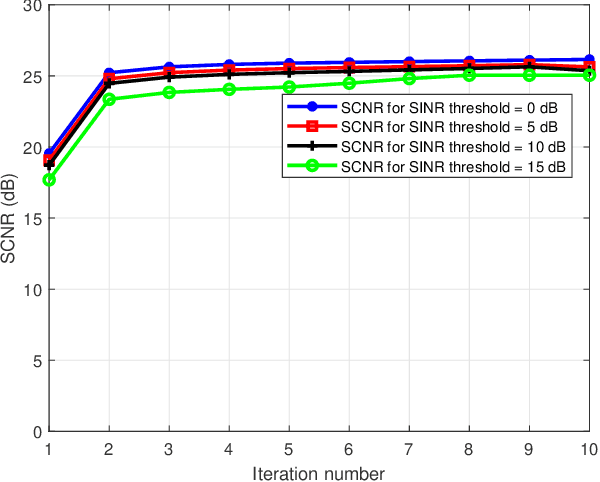
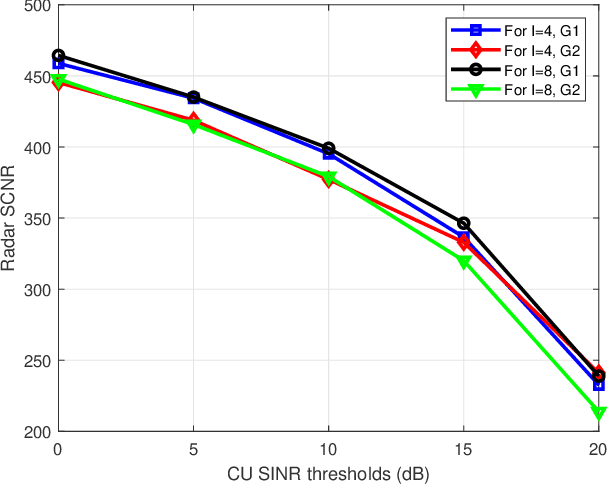
Abstract:Dual functional radar and communication (DFRC) systems are a viable approach to extend the services of future communication systems. Most studies designing DFRC systems assume that the target direction is known. In our paper, we address a critical scenario where this information is not exactly known. For such a system, a signal-to-clutter-plus-noise ratio (SCNR) maximization problem is formulated. Quality-of-service constraints for communication users (CUs) are also incorporated as constraints on their received signal-to-interference-plus-noise ratios (SINRs). To tackle the nonconvexity, an iterative alternating optimization approach is developed where, at each iteration, the optimization is alternatively performed with respect to transmit and receive beamformers. Specifically, a penalty-based approach is used to obtain an efficient sub-optimal solution for the resulting subproblem with regard to transmit beamformers. Next, a globally optimal solution is obtained for receive beamformers with the help of the Dinkleback approach. The convergence of the proposed algorithm is also proved by proving the nondecreasing nature of the objective function with iterations. The numerical results illustrate the effectiveness of the proposed approach. Specifically, it is observed that the proposed algorithm converges within almost 3 iterations, and the SCNR performance is almost unchanged with the number of possible target directions.
Target Handover in Distributed Integrated Sensing and Communication
Nov 04, 2024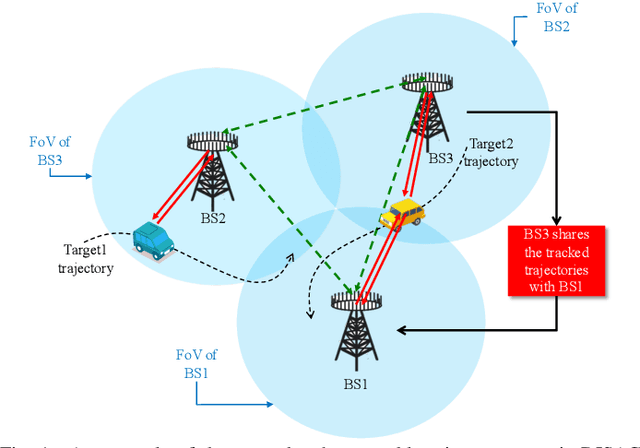
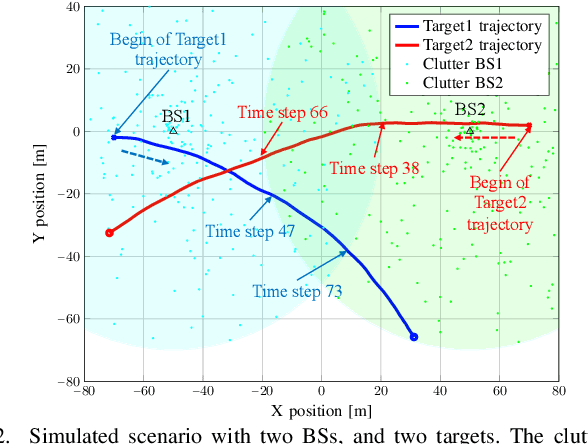
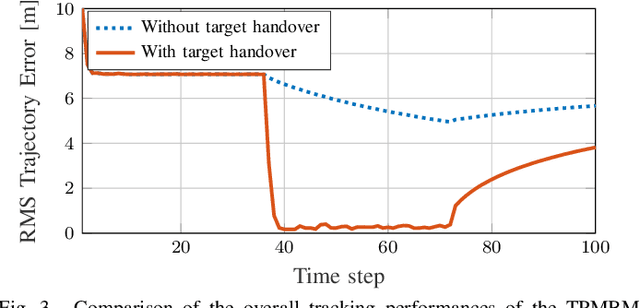
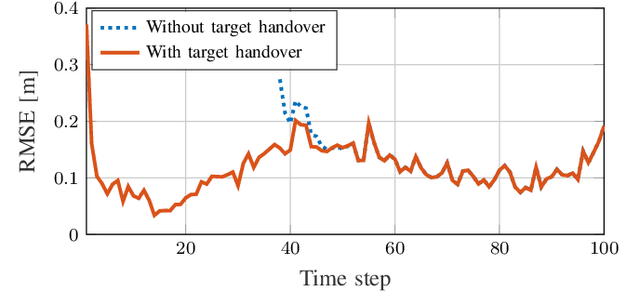
Abstract:The concept of 6G distributed integrated sensing and communications (DISAC) builds upon the functionality of integrated sensing and communications (ISAC) by integrating distributed architectures, significantly enhancing both sensing and communication coverage and performance. In 6G DISAC systems, tracking target trajectories requires base stations (BSs) to hand over their tracked targets to neighboring BSs. Determining what information to share, where, how, and when is critical to effective handover. This paper addresses the target handover challenge in DISAC systems and introduces a method enabling BSs to share essential target trajectory information at appropriate time steps, facilitating seamless handovers to other BSs. The target tracking problem is tackled using the standard trajectory Poisson multi-Bernoulli mixture (TPMBM) filter, enhanced with the proposed handover algorithm. Simulation results confirm the effectiveness of the implemented tracking solution.
DECT-2020 NR Link Distance Performance in Varying Environments: Models and Measurements
Oct 31, 2024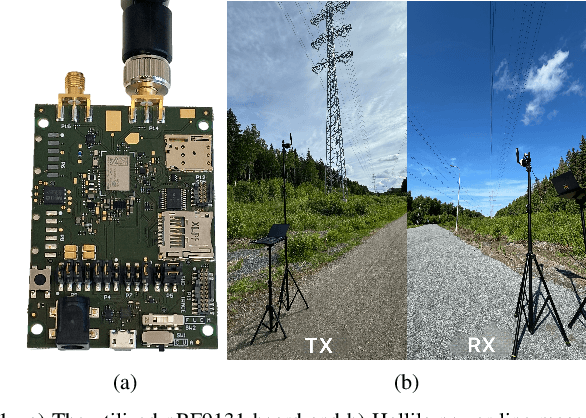
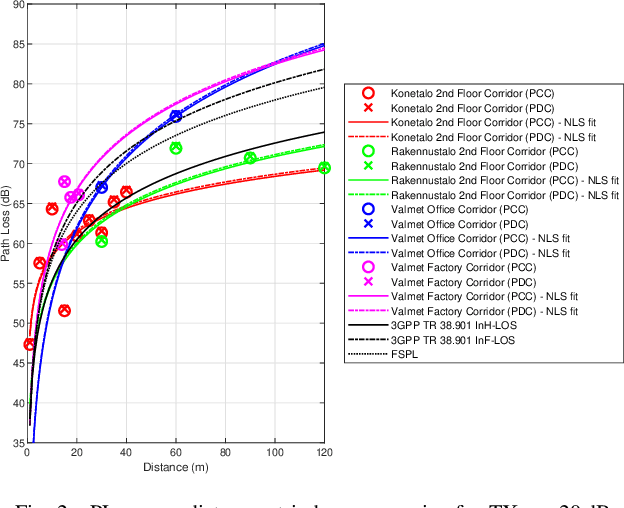

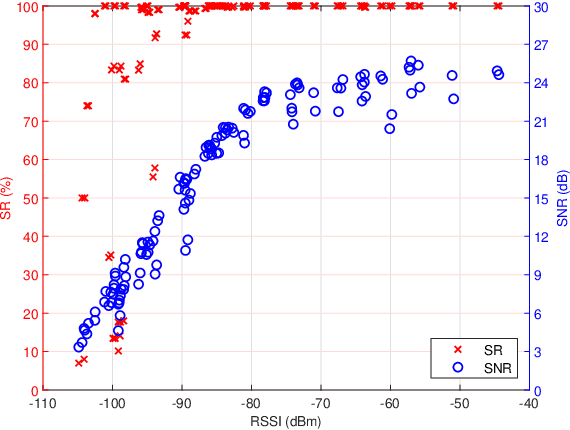
Abstract:Digital Enhanced Cordless Telecommunications 2020 New Radio (DECT-2020 NR) has garnered recognition as an alternative for cellular 5G technology in the internet of things industry. This paper presents a study centered around the analysis of the link distance performance in varying environments for DECT-2020 NR. The study extensively examines and analyzes received signal strength indicator and resulting path loss values in comparison with theoretical models, as well as packet success rates (SR) and signal-to-noise ratio against varying distances. The measurements show that with an SR of over 90%, an antenna height of 1.5 m, indoor link distances with a single device-to-device connection with 0 dBm transmission (TX) power can reach over 60 m in non-line-of-sight (NLOS) areas and up to 190 m in LOS areas with smaller -8 dBm TX power. Similarly, for outdoor use cases, link distances of over 600 m can be reached with +19 dBm TX power.
Batch SLAM with PMBM Data Association Sampling and Graph-Based Optimization
Jul 16, 2024



Abstract:Simultaneous localization and mapping (SLAM) methods need to both solve the data association (DA) problem and the joint estimation of the sensor trajectory and the map, conditioned on a DA. In this paper, we propose a novel integrated approach to solve both the DA problem and the batch SLAM problem simultaneously, combining random finite set (RFS) theory and the graph-based SLAM approach. A sampling method based on the Poisson multi-Bernoulli mixture (PMBM) density is designed for dealing with the DA uncertainty, and a graph-based SLAM solver is applied for the conditional SLAM problem. In the end, a post-processing approach is applied to merge SLAM results from different iterations. Using synthetic data, it is demonstrated that the proposed SLAM approach achieves performance close to the posterior Cram\'er-Rao bound, and outperforms state-of-the-art RFS-based SLAM filters in high clutter and high process noise scenarios.
Multicarrier ISAC: Advances in Waveform Design, Signal Processing and Learning under Non-Idealities
Jun 26, 2024Abstract:This paper addresses the topic of integrated sensing and communications (ISAC) in 5G and emerging 6G wireless networks. ISAC systems operate within shared, congested or even contested spectrum, aiming to deliver high performance in both wireless communications and radio frequency (RF) sensing. The expected benefits include more efficient utilization of spectrum, power, hardware (HW) and antenna resources. Focusing on multicarrier (MC) systems, which represent the most widely used communication waveforms, it explores the co-design and optimization of waveforms alongside multiantenna transceiver signal processing for communications and both monostatic and bistatic sensing applications of ISAC. Moreover, techniques of high practical relevance for overcoming and even harnessing challenges posed by non-idealities in actual transceiver implementations are considered. To operate in highly dynamic radio environments and target scenarios, both model-based structured optimization and learning-based methodologies for ISAC systems are covered, assessing their adaptability and learning capabilities under real-world conditions. The paper presents trade-offs in communication-centric and radar-sensing-centric approaches, aiming for an optimized balance in densely used spectrum.
 Add to Chrome
Add to Chrome Add to Firefox
Add to Firefox Add to Edge
Add to Edge